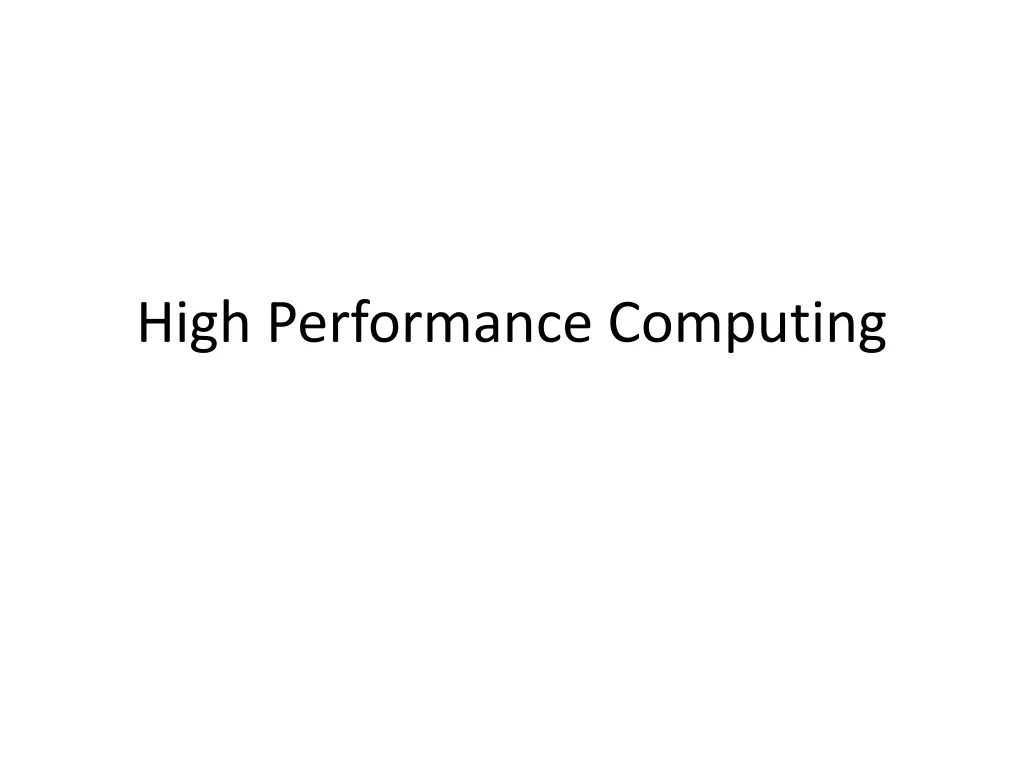
Understanding High Performance Computing and NUMA Architectures
Explore the world of High Performance Computing (HPC) and delve into the intricacies of Non-Uniform Memory Access (NUMA) architectures. Discover the differences between Uniform Memory Access (UMA) and NUMA, the challenges of cache coherence, and the benefits of Cache Coherent NUMA (CC-NUMA) organizations. Learn about the motivation behind NUMA systems and how they provide scalable multiprocessing solutions for modern computing needs.
Download Presentation

Please find below an Image/Link to download the presentation.
The content on the website is provided AS IS for your information and personal use only. It may not be sold, licensed, or shared on other websites without obtaining consent from the author. If you encounter any issues during the download, it is possible that the publisher has removed the file from their server.
You are allowed to download the files provided on this website for personal or commercial use, subject to the condition that they are used lawfully. All files are the property of their respective owners.
The content on the website is provided AS IS for your information and personal use only. It may not be sold, licensed, or shared on other websites without obtaining consent from the author.
E N D
Presentation Transcript
Recap SMP Clustering
Todays topics NUMA (Non-Uniform Memory Access) Cache Coherence
Nonuniform Memory Access (NUMA) UMA: Uniform memory access All processors have access to all parts of memory Using load & store Access time to all regions of memory is the same Access time to memory for different processors same As used by SMP Nonuniform memory access All processors have access to all parts of memory Using load & store Access time of processor differs depending on region of memory Different processors access different regions of memory at different speeds Cache coherent NUMA Cache coherence is maintained among the caches of the various processors Significantly different from SMP and clusters
Motivation SMP has practical limit to number of processors Bus traffic limits to between 16 and 64 processors In clusters each node has own memory Apps do not see large global memory Coherence maintained by software not hardware NUMA retains SMP flavour while giving large scale multiprocessing e.g. Silicon Graphics Origin NUMA 1024 MIPS R10000 processors Objective is to maintain transparent system wide memory while permitting multiprocessor nodes, each with own bus or internal interconnection system
CC-NUMA Operation Each processor has own L1 and L2 cache Each node has own main memory Nodes connected by some networking facility Each processor sees single addressable memory space Memory request order: L1 cache (local to processor) L2 cache (local to processor) Main memory (local to node) Remote memory Delivered to requesting (local to processor) cache Automatic and transparent
Cache Coherence Node 1 directory keeps note that node 2 has copy of data If data modified in cache, this is broadcast to other nodes Local directories monitor and purge local cache if necessary Local directory monitors changes to local data in remote caches and marks memory invalid until writeback Local directory forces writeback if memory location requested by another processor
NUMA Pros & Cons Effective performance at higher levels of parallelism than SMP No major software changes Performance can breakdown if too much access to remote memory Can be avoided by: L1 & L2 cache design reducing all memory access Need good temporal locality of software Good spatial locality of software Virtual memory management moving pages to nodes that are using them most Not transparent Page allocation, process allocation and load balancing changes needed Availability?
Cache Coherence In SMP or NUMA, multiple copies of cache Each copy may have a different value of data item Maintain Coherency How?
Cache Coherence: Two Approaches Write back: Update Main memory once cache is flushed. Write through: Write is updated to cache as well as to the main memory.
Implementations Software Solutions: Compile time decision Conservative Inefficient cache utilization Hardware Solutions: Runtime decision More effective
Hardware based solution Directory Protocol Snoopy Protocol
Directory Centralized Controller Individual cache controller makes a request Centralized controller checks and issues command Updates information
Directory Write Processor requests exclusive writes Controller sends message Invalidates Read Issues command to the processor Holding Processor Writes back to MM Read permitted
Directory Disadvantage Centralized Controller Bottleneck Advantage Useful in large scale system
Snoopy Protocol Update operation announced All Cache controllers snoop Bus architecture Careful Increased Bus Traffic
Snoopy Protocol Two approaches Write Invalidate One write Multiple readers Exclusive: Writer invalidates others entries Write Update Multiple writers All writes are updated
Write Invalidate The MESI Protocol : P4 processor Data cache: Two status bits, 4 states Modified Exclusive Shared Invalid See Table






















